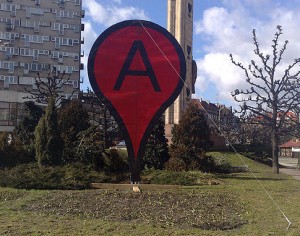January 1988. My first ever job interview, with Brook St Bureau. The job itself (which I didn’t get) I’d seen advertised in the Express and Star the preceding Thursday. I’d sent a hand-written CV in the post along with an introductory letter. Not just for this job – I’d sent off for a dozen jobs in all.
After three days watching the letterbox (morning and afternoon – we had two deliveries a day, then), the invitation to interview came back from Brook Street.
The day before the big event, I’d taken out the A-to-Z to discover exactly where the street was. No big red balloon to pinpoint the location. Just a street name. Where the bureau sat on that street, I had no idea. Just like I had no idea what it was the bureau did. Nor, if memory serves, had I an inkling of what the job I’d applied for truly entailed.
Planning the road to interview success
I set off with some 10p pieces in my pocket, besides my bus fare. The coins sat in my pocket, along with a scrap of paper with the agency’s phone number on it (taken from the mahoosive Yellow Pages). The ten-pence-pieces? If the bus was going to make me late, I could use the phone box at the depot and call ahead.

With my suit on, a cat-lick of a shave and wearing the first tie I’d worn since being asked to leave Sixth Form, I was ready.
Upon reaching the other side of Wolverhampton, I was all of a fluster. It was freezing cold, my trousers were covered in slush and my nose as red as if I’d been on the sauce since childhood. No wonder the interview never led to my first proper job.
They said they’d keep my CV on record, though, in the rejection letter that came the following week. Just in case something else popped up, they wrote. As much as I know, it could still be there.
That I didn’t get the job is neither here nor there. What I want stress is the time it used to take just to get turned down for a job. My guess, the best part of two weeks, from seeing the job to getting the ‘thanks, but no thanks’ letter.
Recruitment is unrecognisable and that’s a fax
What was the catalyst for this impromptu trip down memory lane? Well, I’ve just been reading two articles on the state of recruitment today.
The first, on APSCo, reports on an Android app through which you can conduct your interview.
The software firm behind the app, The Needle, are no strangers to this process. They have a whole host of products to help firms and agencies conduct video interviews.
They offer bespoke, tailored solutions for video interviews. The initial screening test can be shared with all stakeholders in the hiring process. And with this latest addition, potential candidates can participate in an interview from their phone or iPad in the comfort of their own home.
No traipsing through soot-showered snow on a freezing January morning with this technology. No waiting in for the second post. And no tearing pages out the Yellow Pages and A-to-Z to see where you might be headed.
Screening on your mobile? There’s an app for that
The second article, on CV-library, serves to remind us of the growing trend of social in the recruiting process. Moreover the importance of mobile use in that process.
LinkedIn recently found that almost three quarters (72%) of people looking for a job did their homework before making contact. And it’s a two way street. Yes, your website serves to tell candidates what it is you do as a company. But it’s also important for them to see if their make up is a good fit for the company culture.
And they’re not just browsing on their mobile device, either. Almost half of the job seekers LinkedIn surveyed (45%) actually applied online through said device.
There are two messages about the way interviewing is headed, here:
- candidates needn’t suffer the insufferable British weather and cost of getting to an interview, at least at the screening interview stage. That Google Maps now pinpoints the exact location and maybe even shows the coffee machine in the reception in Street View seems wasted;
- firms need to consider what their website says about them. Not just to customers, but to potential employees.
The latter is mega important for businesses. The second article’s point was that the skills’ gap continues to widen. Firms need to find ways of attracting and retaining skilled technicians if they are to remain competitive in their niche.
With freelancers and contractors in particular used to scouting out gigs with potential employers online, a website is a firm’s landing net. Best keep them maintained if they don’t want to let the big fish slip through it.
Image: Public Domain

